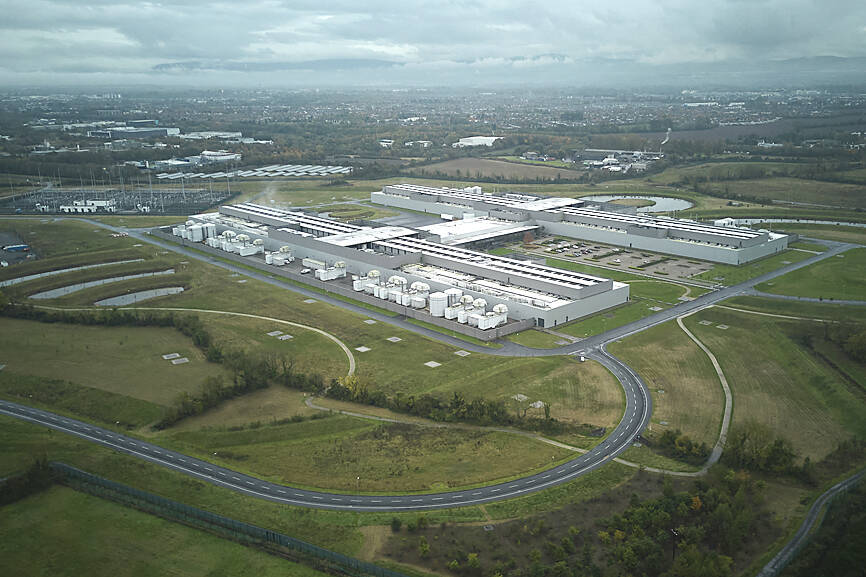Ireland hosts one of the world’s fast-growing clusters of data centers, but is running headlong into the difficult consequences.
The server farms powering global tech giants consume one-fifth of the small nation’s electricity, igniting concerns over grid stability, and Ireland’s commitments to boost renewable energies and cut gas emissions.
Already home to more than 80 data centers, a report by US-based researchers Synergy last year ranked Dublin behind only the US’ Virginia and Beijing in its density of such state-of-the-art facilities built for colossal amounts of data.

Photo: AP
Vast energy-hungry warehouses around Dublin’s ring road host thousands of servers handling massive amounts of cloud computing, storage and artificial intelligence (AI) demands for data giants such Google, Meta Platforms Inc, Microsoft Corp and Amazon.com Inc.
The facilities are a quietly purring economic engine, injecting billions in investment, employment and anchoring the tech multinationals which, coupled with big pharma, fund more than half of Ireland’s corporate-tax take, analysts said.
However, doubts are mounting over the environmental cost.
Such centers are “completely unsustainable,” campaigner group Friends of the Earth said.
“It’s one of the fundamental climate justice issues of our times,” spokeswoman Rosi Leonard said.
Data centers’ share of Irish metered electricity consumption reached 22 percent by last year, compared with an EU-wide average of 2 to 3 percent, official data showed.
Irish national grid operator EirGrid PLC projects that data centers could account for 30 percent of demand by 2030 as the growth of artificial intelligence technology accelerates.
That is equivalent to powering 2 million homes for a full year, energy analysts Wood Mackenzie said in July.
Some data centers in high-pressure areas in Dublin have already turned to generators for backup, which are usually gas and oil-powered, Leonard said.
That could hamper Ireland’s already fraught efforts to meet EU 2030 climate targets that threaten multibillion euro fines if missed.
The server farms are also gobbling up much of the renewable energy such as wind and solar that is being added to the grid, Leonard said.
“We want a moratorium on further expansion of data centers until they pose no threat to our climate and carbon budgets,” she said.
EirGrid plans capacity upgrades to accommodate future data center demand more evenly nationwide. The Irish government has said a new strategy would be published soon with a pledge to update the grid within five years.
However, experts doubt whether those plans could deliver in time to meet demand.
As Ireland aims “to reduce emissions ... expanding a sector that’s going to increase emissions very significantly just ... doesn’t make sense,” Dublin City University climate change expert Barry McMullin said.
Data center compatibility with emissions goals “is unlikely for another decade,” he said.
Some planning authorities have already pushed back.
Last year, a local council in Dublin refused a Google data center development, citing “insufficient [grid] capacity” and a “lack of significant on-site renewable energy.”
Ireland’s digital sector contributes an estimated 13 percent to GDP.
However, Maurice Mortell, head of Digital Infrastructure Ireland, a group representing data centers, said the nation could lose out on AI-driven investment due to grid and planning blockages.
“We’ve over 18 billion euros (US$20.73 billion) of investment in digital infrastructure here already, with another 5.8 billion planned, but without power, so potentially marooned,” he said.
“Ireland’s lead, particularly in cloud computing, is at risk,” he said, highlighting its fading appeal and frustrations from large US firms.
“Our sector is in limbo, we need a grid that’s capable and a clear policy environment,” he said.
A 2022 Irish government strategy paper said data centers should demonstrate a “clear pathway” to decarbonize and net-zero “data services by design.”
Meanwhile, a project launched in 2023 by Amazon Web Services (AWS) in partnership with a local Dublin authority shows how some climate impacts could be offset.
Waste heat provided from an AWS data center is carried via hot water through pipes to a local heating hub next door to heat offices and a library, and soon hundreds of homes.
“There is potential for other data centers to do the same,” said Admir Shala, a project manager at the heating hub called Heatworks.
However, McMullin was skeptical.
“We don’t really have heat networks to plug this waste heat into,” he said, adding that data centers run year-round whereas homes only need to be heated for about six months a year.

JITTERS: Nexperia has a 20 percent market share for chips powering simpler features such as window controls, and changing supply chains could take years European carmakers are looking into ways to scratch components made with parts from China, spooked by deepening geopolitical spats playing out through chipmaker Nexperia BV and Beijing’s export controls on rare earths. To protect operations from trade ructions, several automakers are pushing major suppliers to find permanent alternatives to Chinese semiconductors, people familiar with the matter said. The industry is considering broader changes to its supply chain to adapt to shifting geopolitics, Europe’s main suppliers lobby CLEPA head Matthias Zink said. “We had some indications already — questions like: ‘How can you supply me without this dependency on China?’” Zink, who also

The number of Taiwanese working in the US rose to a record high of 137,000 last year, driven largely by Taiwan Semiconductor Manufacturing Co’s (TSMC, 台積電) rapid overseas expansion, according to government data released yesterday. A total of 666,000 Taiwanese nationals were employed abroad last year, an increase of 45,000 from 2023 and the highest level since the COVID-19 pandemic, data from the Directorate-General of Budget, Accounting and Statistics (DGBAS) showed. Overseas employment had steadily increased between 2009 and 2019, peaking at 739,000, before plunging to 319,000 in 2021 amid US-China trade tensions, global supply chain shifts, reshoring by Taiwanese companies and

Taiwan Semiconductor Manufacturing Co (TSMC, 台積電) received about NT$147 billion (US$4.71 billion) in subsidies from the US, Japanese, German and Chinese governments over the past two years for its global expansion. Financial data compiled by the world’s largest contract chipmaker showed the company secured NT$4.77 billion in subsidies from the governments in the third quarter, bringing the total for the first three quarters of the year to about NT$71.9 billion. Along with the NT$75.16 billion in financial aid TSMC received last year, the chipmaker obtained NT$147 billion in subsidies in almost two years, the data showed. The subsidies received by its subsidiaries —

OUTLOOK: Pat Gelsinger said he did not expect the heavy AI infrastructure investments by the major cloud service providers to cause an AI bubble to burst soon Building a resilient energy supply chain is crucial for Taiwan to develop artificial intelligence (AI) technology and grow its economy, former Intel Corp chief executive officer Pat Gelsinger said yesterday. Gelsinger, now a general partner at the US venture capital firm Playground Global LLC, was asked at a news conference in Taipei about his views on Taiwan’s hardware development and growing concern over an AI bubble. “Today, the greatest issue in Taiwan isn’t even in the software or in architecture. It is energy,” Gelsinger said. “You are not in the position to have a resilient energy supply chain, and that,